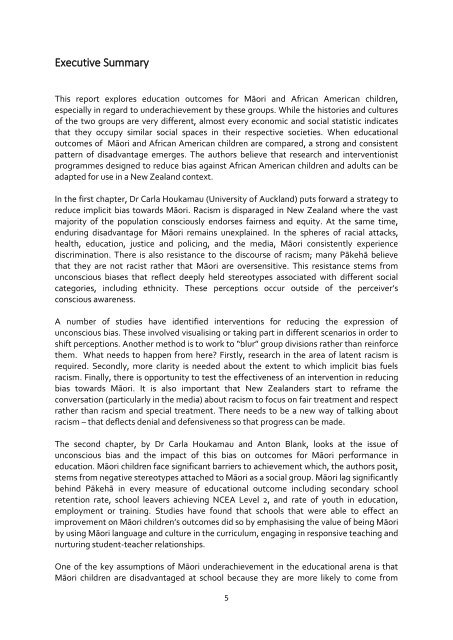UNCONSCIOUS BIAS AND EDUCATION
unconsious-bias-and-education
unconsious-bias-and-education
Create successful ePaper yourself
Turn your PDF publications into a flip-book with our unique Google optimized e-Paper software.
Executive Summary<br />
This report explores education outcomes for Māori and African American children,<br />
especially in regard to underachievement by these groups. While the histories and cultures<br />
of the two groups are very different, almost every economic and social statistic indicates<br />
that they occupy similar social spaces in their respective societies. When educational<br />
outcomes of Māori and African American children are compared, a strong and consistent<br />
pattern of disadvantage emerges. The authors believe that research and interventionist<br />
programmes designed to reduce bias against African American children and adults can be<br />
adapted for use in a New Zealand context.<br />
In the first chapter, Dr Carla Houkamau (University of Auckland) puts forward a strategy to<br />
reduce implicit bias towards Māori. Racism is disparaged in New Zealand where the vast<br />
majority of the population consciously endorses fairness and equity. At the same time,<br />
enduring disadvantage for Māori remains unexplained. In the spheres of racial attacks,<br />
health, education, justice and policing, and the media, Māori consistently experience<br />
discrimination. There is also resistance to the discourse of racism; many Pākehā believe<br />
that they are not racist rather that Māori are oversensitive. This resistance stems from<br />
unconscious biases that reflect deeply held stereotypes associated with different social<br />
categories, including ethnicity. These perceptions occur outside of the perceiver’s<br />
conscious awareness.<br />
A number of studies have identified interventions for reducing the expression of<br />
unconscious bias. These involved visualising or taking part in different scenarios in order to<br />
shift perceptions. Another method is to work to “blur” group divisions rather than reinforce<br />
them. What needs to happen from here? Firstly, research in the area of latent racism is<br />
required. Secondly, more clarity is needed about the extent to which implicit bias fuels<br />
racism. Finally, there is opportunity to test the effectiveness of an intervention in reducing<br />
bias towards Māori. It is also important that New Zealanders start to reframe the<br />
conversation (particularly in the media) about racism to focus on fair treatment and respect<br />
rather than racism and special treatment. There needs to be a new way of talking about<br />
racism – that deflects denial and defensiveness so that progress can be made.<br />
The second chapter, by Dr Carla Houkamau and Anton Blank, looks at the issue of<br />
unconscious bias and the impact of this bias on outcomes for Māori performance in<br />
education. Māori children face significant barriers to achievement which, the authors posit,<br />
stems from negative stereotypes attached to Māori as a social group. Māori lag significantly<br />
behind Pākehā in every measure of educational outcome including secondary school<br />
retention rate, school leavers achieving NCEA Level 2, and rate of youth in education,<br />
employment or training. Studies have found that schools that were able to effect an<br />
improvement on Māori children’s outcomes did so by emphasising the value of being Māori<br />
by using Māori language and culture in the curriculum, engaging in responsive teaching and<br />
nurturing student-teacher relationships.<br />
One of the key assumptions of Māori underachievement in the educational arena is that<br />
Māori children are disadvantaged at school because they are more likely to come from<br />
5


